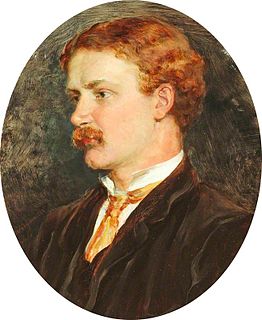
Sir William Hamo Thornycroft was an English sculptor, responsible for some of London's best-known statues, including the statue of Oliver Cromwell outside the Palace of Westminster. He was a keen student of classical sculpture and was one of the youngest artists to be elected to the Royal Academy, in 1882, the same year the bronze cast of Teucer was purchased for the British nation under the auspices of the Chantrey Bequest.

The Thinker is a bronze sculpture by Auguste Rodin, usually placed on a stone pedestal. The work depicts a nude male figure of heroic size sitting on a rock. He is seen leaning over, his right elbow placed on his left thigh, holding the weight of his chin on the back of his right hand. The pose is one of deep thought and contemplation, and the statue is often used as an image to represent philosophy.

The Little Fourteen-Year-Old Dancer is a sculpture begun c. 1880 by Edgar Degas of a young student of the Paris Opera Ballet dance school, a Belgian named Marie van Goethem.

Appeal to the Great Spirit is a 1908 equestrian statue by Cyrus Dallin, located in front of the Museum of Fine Arts, Boston. It portrays a Native American on horseback facing skyward, his arms spread wide in a spiritual request to the Great Spirit. It was the last of four prominent sculptures of Indigenous people, which also includes A Signal of Peace (1890), The Medicine Man (1899), and Protest of the Sioux (1904).

Neil Lawson Baker is a British artist, sculptor and photographer.
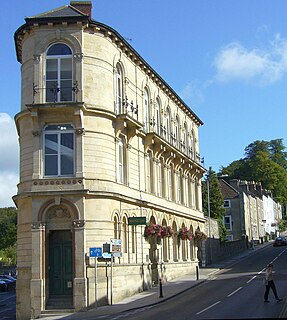
Frome Museum in Frome, Somerset, England houses a collection of local history and has a particular important collection of artefacts from the bronze foundry of J.W.Singer.

Two Figures is a bronze sculpture by the English sculptor Barbara Hepworth, which was cast in an edition of seven copies. One of these is located at Newfields, the campus that also houses the Indianapolis Museum of Art in Indianapolis, Indiana. Other casts are at Southampton University, the Fred Jones Jr. Museum of Art at the University of Oklahoma, Commonwealth Park in Canberra Australia, and the Hakone Open-Air Museum, Hakone, Japan. The series were cast at the Morris Singer Foundry in London from 1968 onwards. Another cast of this work could also be found at the University of Birmingham Vale site, but is no longer present as of January 2, 2012.

Sea Form (Atlantic) is a 1964 bronze sculpture by English artist Barbara Hepworth. It measures 204 cm × 107 cm × 73 cm.
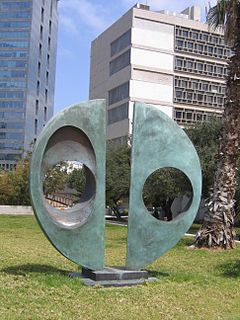
Two Forms is a bronze sculpture by Barbara Hepworth, designed in 1969. Six numbered copies were cast, plus one (0/6) retained by the sculptress. The sculpture's dimensions are 237 centimetres (93 in) by 234 centimetres (92 in) by 54 centimetres (21 in).

Sphere with Inner Form is a bronze sculpture by English artist Barbara Hepworth, with six castings made in 1963 and two more 1965. It is sometimes interpreted as a child in a pregnant woman's womb, or as a metaphor for the creation of a sculpture.

The Arts of War and The Arts of Peace are bronze, fire-gilded statue groups on Lincoln Memorial Circle in West Potomac Park in Washington, D.C., in the United States. Commissioned in 1929 to complement the plaza constructed on the east side of the Lincoln Memorial as part of the Arlington Memorial Bridge approaches, their completion was delayed until 1939 for budgetary reasons. The models were placed into storage, and the statues not cast until 1950. They were erected in 1951, and repaired in 1974.
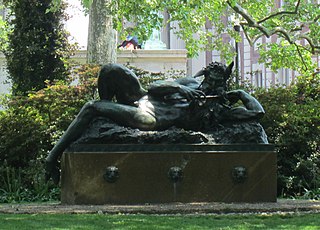
The Great God Pan is a bronze sculpture by American sculptor George Grey Barnard. Since 1907, it has been a fixture of the Columbia University campus in Manhattan, New York City.

Boadicea and Her Daughters is a bronze sculptural group in London representing Boudica, queen of the Celtic Iceni tribe, who led an uprising in Roman Britain. It is located to the north side of the western end of Westminster Bridge, near Portcullis House and Westminster Pier, facing Big Ben and the Palace of Westminster across the road. It is considered the magnum opus of its sculptor, the English artist and engineer Thomas Thornycroft. Thornycroft worked on it from 1856 until shortly before his death in 1885, sometimes assisted by his son William Hamo Thornycroft, but it was not erected in its current position until 1902.

Wind Gate, also known as Wind Passage and Windgate, is an outdoor bronze sculpture by American artist Hilda Grossman Morris, located in front of Eliot Hall on the Reed College campus in Portland, Oregon, United States. It was created during 1967–1968 and permanently installed on the campus in 1980.

Thomas Jefferson is a 1911 bronze statue of a seated Thomas Jefferson created by Karl Bitter for the Cuyahoga County Courthouse in Cleveland, Ohio, United States.
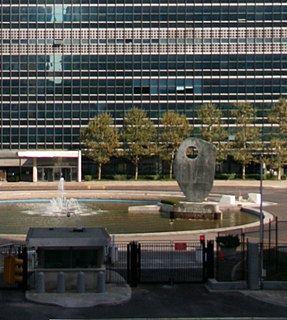
Single Form is a monumental bronze sculpture by the British artist Barbara Hepworth. It is her largest work, and one of her most prominent public commissions, displayed since 1964 in a circular water feature that forms a traffic island at the Headquarters of the United Nations in New York City, outside the United Nations Secretariat Building and the Dag Hammarskjöld Library. It is also the largest artwork cast by the Morris Singer foundry.
Meridian is a bronze sculpture by British artist Barbara Hepworth. It is an early example of her public commissions, commissioned for State House, a new 16-storey office block constructed at 66–71 High Holborn, London, in the early 1960s. The sculpture was made in 1958–59, and erected in 1960. When the building was demolished in 1990, the sculpture was sold and moved to the Donald M. Kendall Sculpture Gardens in Purchase, New York.

The Thames Ditton Foundry was a foundry in Thames Ditton, Surrey, which operated from 1874 to 1939 and which under various owners produced numerous major statues and monuments as one of the United Kingdom's leading firms of bronze founders.

Family Group is a sculpture by Henry Moore. It was his first large-scale bronze sculpture, and his first large bronze with multiple castings. Made for Barclay School in Stevenage, it evolved from drawings in the 1930s, through a series of models to bronze castings in 1950–51. It also one of the last important sculptures that Moore developed from preliminary drawings: in future, he worked mainly from found objects, maquettes and models.
John Webb Singer was an English businessman who created a substantial art foundry in Frome, Somerset, known for its statuary and ecclesiastical products. He had assembled immense collections of antique jewellery, rings, wine glasses, snuffboxes, stamps. He took a prominent part in both local and national politics, serving on the Local Board and its successor the Urban District Council, founding the Frome Art School and helping to create the Frome Literary and Scientific Institution. He worked with the leading bronze sculptors of his day.


















